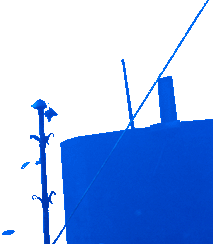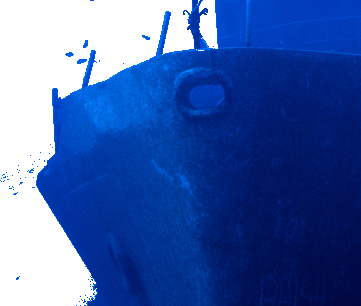
Cozumel Wreck - Felipe Xicotencatl
Story
by ZJ Prochazka
Photos by Bonnie Pelnar
 As
the ship materializes in the current ahead, I finally stop
messing with my new (and so far free-flowing) regulator
and kick toward the bow. A large ship underwater always
seems to halt my bubbles for a moment and I stare at this
massive structure that once rode atop the waves and now
sits beneath them. I swim to the side and read "LARRY" in
giant letters on the superstructure. "Bob" comes
into focus a little to the left. Undoubtedly, these two
are now sitting over margaritas on the main strip, congratulating
themselves on their passage into history. That is, until
the wreck manages to recover the delicate growth to hide
the graffiti scratched onto its side and erase their names
forever. We’re not allowed to penetrate the wreck
as the dive operators do not yet have clearance to take
groups inside. I float around its decks and peek into the
windows where new settlements of tiny blue tang stare back
at me.
As
the ship materializes in the current ahead, I finally stop
messing with my new (and so far free-flowing) regulator
and kick toward the bow. A large ship underwater always
seems to halt my bubbles for a moment and I stare at this
massive structure that once rode atop the waves and now
sits beneath them. I swim to the side and read "LARRY" in
giant letters on the superstructure. "Bob" comes
into focus a little to the left. Undoubtedly, these two
are now sitting over margaritas on the main strip, congratulating
themselves on their passage into history. That is, until
the wreck manages to recover the delicate growth to hide
the graffiti scratched onto its side and erase their names
forever. We’re not allowed to penetrate the wreck
as the dive operators do not yet have clearance to take
groups inside. I float around its decks and peek into the
windows where new settlements of tiny blue tang stare back
at me.
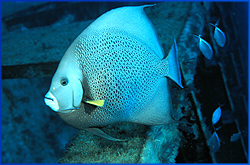 The
sinking of the Cozumel ship was a spectacle that of course,
did not lack for controversy. On one side was the national
marine park, established on July 19, 1996 for the protection
of the reefs, which have great ecological value as well as
significant economic importance to the area as tourist attractions.
Park management argued to add an artificial reef to the already
spectacular natural formations including Punta Sur, Santa
Rosa, Planacar and many other diving favorites. The point
was to create a diversion for divers and to lighten the load
on the coral structures. A variety of pending research projects
were also cited such as the creation of an underwater laboratory
to study the process of colonization and the establishment
of a species and to understand the impact of sunken structures
and their development as artificial reefs.
The
sinking of the Cozumel ship was a spectacle that of course,
did not lack for controversy. On one side was the national
marine park, established on July 19, 1996 for the protection
of the reefs, which have great ecological value as well as
significant economic importance to the area as tourist attractions.
Park management argued to add an artificial reef to the already
spectacular natural formations including Punta Sur, Santa
Rosa, Planacar and many other diving favorites. The point
was to create a diversion for divers and to lighten the load
on the coral structures. A variety of pending research projects
were also cited such as the creation of an underwater laboratory
to study the process of colonization and the establishment
of a species and to understand the impact of sunken structures
and their development as artificial reefs.
On the other side were some individuals and dive operators who felt that the addition of a "greasy" wreck to the natural splendors of Cozumel was unnecessary and posed a pollution risk to the delicate coral. Furthermore, the wreck was viewed as a man-made intrusion into what is a natural, underwater Garden of Eden. Right or wrong, it’s clear to see who won the argument as many boats filled with divers now head directly for the large buoy, which is attached with heavy chain to the metal deck below and marks the location of the ship.
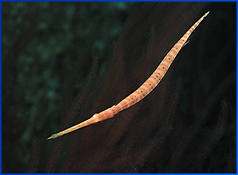 The
sinking was no small affair and demanded months of preparations
most of which were done in the port of Tampico, Tamaulipas.
All floating or non-biodegradable materials, such as wood,
mattresses, stuffing and plastics were removed from her four
decks and interior spaces. The tanks were flushed and cleaned.
The entire boat was scrubbed and large openings were cut
into the decks, hull, and interior corridors in order to
allow divers to enter and leave freely. She was then towed
to Cozumel where, under the supervision of "sinking
experts" during an appropriate weather window in June
of this year, her through-hulls were opened and the hold
flooded. She settled perfectly upright onto 540 square meters
of sand with little trouble except that one of her huge rudders
came loose and now lies about 20 feet behind the wreck.
The
sinking was no small affair and demanded months of preparations
most of which were done in the port of Tampico, Tamaulipas.
All floating or non-biodegradable materials, such as wood,
mattresses, stuffing and plastics were removed from her four
decks and interior spaces. The tanks were flushed and cleaned.
The entire boat was scrubbed and large openings were cut
into the decks, hull, and interior corridors in order to
allow divers to enter and leave freely. She was then towed
to Cozumel where, under the supervision of "sinking
experts" during an appropriate weather window in June
of this year, her through-hulls were opened and the hold
flooded. She settled perfectly upright onto 540 square meters
of sand with little trouble except that one of her huge rudders
came loose and now lies about 20 feet behind the wreck.
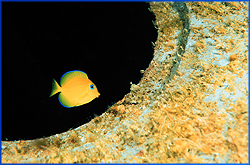 Like
all good ships, this one has an interesting history. She
was built in Tampa, Florida in 1944 by Wilson Marine and
was commissioned for the US Navy as a minesweeper under the
name "Scuffle". She was eventually deactivated
and then donated to the government of Mexico in 1962 when
she began a varied list of duties including work as an anti-drug
patrol boat, a search and rescue ship, a troop transport
and finally as a training vessel for cadets of a naval academy.
After 55 years of service, the ship was retired on the 10th
of June 1999.
Like
all good ships, this one has an interesting history. She
was built in Tampa, Florida in 1944 by Wilson Marine and
was commissioned for the US Navy as a minesweeper under the
name "Scuffle". She was eventually deactivated
and then donated to the government of Mexico in 1962 when
she began a varied list of duties including work as an anti-drug
patrol boat, a search and rescue ship, a troop transport
and finally as a training vessel for cadets of a naval academy.
After 55 years of service, the ship was retired on the 10th
of June 1999.
The coastal waters of Quintana Roo have remained very healthy despite the crossing of Hurricane Gilbert, the near miss of Hurricane Mitch and the unusually warm waters of El Nino. It would be a safe guess that the wreck will not disturb the delicate ecology of the nearby reefs, and that in fact, it will eventually serve its original purpose of alleviating diver traffic on the coral reefs and providing a new home to many creatures. As long and the wreck gets a fair chance of attracting marine life, the ship will likely blend in and add to the already world-class diving of the island. I hope that Cozumel’s dive masters will be able to manage the Larry’s and Bob’s and keep them from attempting to make themselves "immortal". I’ll know when I return in a few months to see how the Xicotencatl has progressed.
